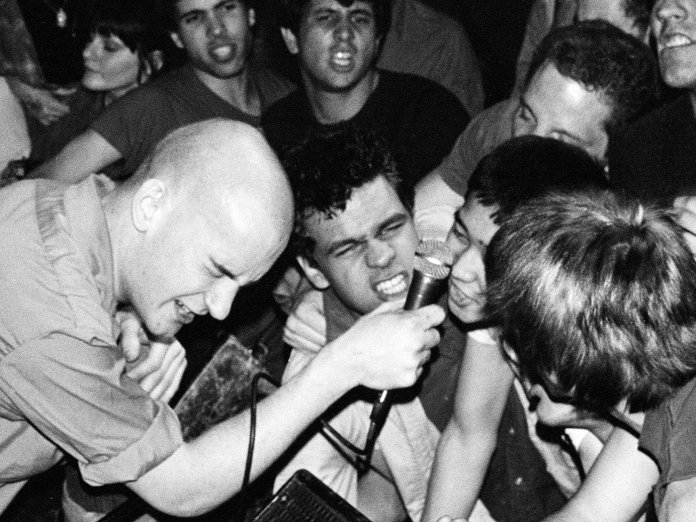As they bickered throughout the final days of Minor Threat, drummer Jeff Nelson told
singer Ian MacKaye that – as unwashed jocks from the ’burbs started to infiltrate their well-marshalled scene – he wasn’t really enjoying playing with the DC hardcore giants any more. Righteous fire forever burning in his eyes, MacKaye replied: “It’s not supposed to be fun.”
Packed with great footage and interviews, James June Schneider and Paul Bishow’s excellent doc on the evolution of Washington, DC’s mutant strain of punk shows how a teenage passion morphed into a full-on crusade. The comic-store nerds and Clash copyists who first thrashed out tunes at The Keg (“a heavy metal dump next to a strip bar”, so says the Slickee Boys’ Howard Wuelfing) in the late ’70s were crowded out by shaven-headed, middle-class hellions seeking a riot entirely of their own.
DC was a musical hinterland in the 1970s, with foundational punk acts such as Overkill and father-and-son shock-rockers White Boy (Google with care) pairing ripped T-shirts with flares and long hair as they sought new ways to tell the world that disco sucked. However, that tiny world began to expand when Bad Brains – black, jazz-fusion heads inspired by “positive mental attitude” self-help guru Napoleon Hill’s 1937 manual Think And Grow Rich – heard the Sex Pistols and the Dead Boys and decided that they could do it better.
“We listened to the Ramones and The Damned and we said, ‘Well, they’re jumping so we’re gonna jump too, but we gotta be able to jump higher, quicker,’” remembers guitarist Darryl Jenifer. They raised the musical tempo as well. As Jenifer puts it: “If the Ramones think they’re playing fast, watch this.”
High-energy footage confirms Bad Brains’ reputation as a life-altering live band, but if their departure for New York – and back-flipping singer HR’s subsequent mental health issues – was a setback for DC, the baton was taken up by Woodrow Wilson High School classmates MacKaye and Nelson. Their first band, the Teen Idles, achieved moderate local success before splitting in 1980. With the final $600 in their band account, they made a record. The first release on their Dischord label, it was the start of a campaign to define and document an inward-looking Washington sound, unsullied by the need for critical approval they perceived in nearby New York. As Nelson puts it: “When you’re working in isolation, sometimes you come up with the best stuff.”
Nelson and MacKaye’s next act proved that – as important as Black Flag or Ramones in defining the evolution of the US underground, Minor Threat were lightning fast, with killer shout-along choruses. When future Black Flag singer and DC scenester Henry Rollins saw their first shows, he thought: “Finally we have our Beatles.”
Minor Threat also had a message. Annoyed at the Sid Vicious-style “self-destructive junkie culture” prevalent in punk circles, MacKaye evolved an aggressively wholesome no-alcohol, no-drugs, no-casual-sex ethos, which Minor Threat espoused in songs such as “Straight Edge” and “Out Of Step”. Footage of a topless MacKaye inviting audience participation at one gig shows how effectively he got that across.
Punk The Capital perhaps downplays how obnoxious and violent MacKaye and his crew were at this messianic peak, but it shows how increasingly intense male bonding at gigs fractured the once small, supportive, women-friendly DC scene. Headcases, misogynists and white supremacists entered the moshpit, while MacKaye’s ascetic values seeded more intolerant scenes in Boston, New York and beyond. Determined anti-careerists, Minor Threat got out while they were up, dissolving along with the other key Dischord bands – SOA, Faith et al – to regenerate into a next wave of less didactic DC acts: Rites Of Spring, Dag Nasty, and MacKaye’s Embrace and Fugazi.
The wealth of great video footage in Punk The Capital underlines what made DC hardcore unique; the main protagonists were not marginal dropouts, as they were in New York and California, but the well-heeled, eloquent children of admirals, diplomats and journalists, with the will and means to succeed without outside support. They were young hotheads with a genuine vision; abrasive but, in their determined rejection of lax values and espousal of DIY thrift, as American as the Mayflower. “It wasn’t a dress-up thing,” says the still saintly MacKaye. “We were going to live it.” Not fun: fundamentalism.



